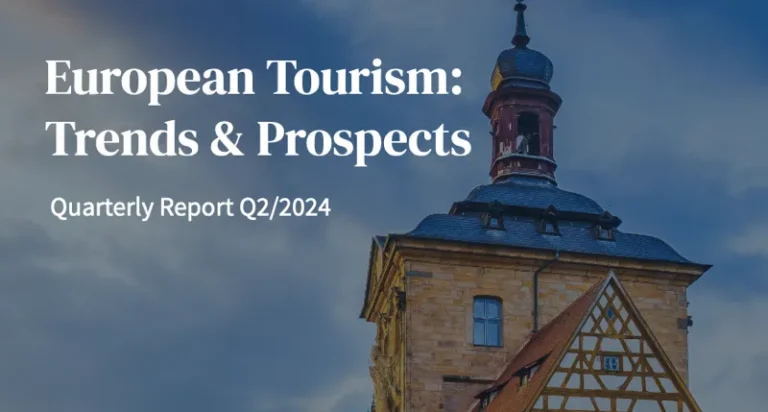
European tourism to reach new highs in 2024 as travellers’ plans diversify
Strong recovery: International tourist numbers and overnight stays in the first half of 2024 will surpass 2019 figures Regional leaders: Southern European and Mediterranean destinations will see a notable increase in tourist numbers, led by Serbia, Malta and Portugal Tourism diversification: Increased travel to lesser known destinations such as Albania and Montenegro Increased spending: European tourists are expected to spend €800.5 billion in 2024, up 13.7% since 2023 Positive sentiment online: Discussions highlight the appeal of less crowded destinations and sustainable travel
European tourism continued to recover in Q2 2024. International visitor numbers (+6%) and overnight stays (+7%) surpassed 2019 figures, increasing 12% and 10% year-on-year respectively. This growth is driven by increased intra-regional travel from Germany, France, Italy and the Netherlands.
This is according to the latest edition of the quarterly report “Trends and Outlook for European Tourism”, published today by the European Travel Commission (ETC), which monitors the performance of European tourism in the second quarter of 2024 and provides a comprehensive analysis of the latest tourism and macroeconomic trends in the region.
Commenting on the report’s release, ETC President Miguel Sanz said: “We are pleased to see a growing diversification of Europe’s tourism industry this quarter, which benefits both emerging destinations that may face overcrowding and established popular spots. Furthermore, increased tourist numbers in lesser known areas will help smaller businesses that are still recovering from the pandemic or struggling with rising operating costs due to the current economic situation. We welcome a more balanced spread of tourism across Europe, which will contribute to improving the sustainability of our industry.”
Established and emerging destinations in Southern Europe maintain their appeal
Data so far this year shows that traditional and non-traditional Southern European and Mediterranean destinations remain the most popular choices for European tourists. Compared to 2019 levels, lesser known destinations such as Serbia (+40%) and Bulgaria (+29%), as well as perennial favourites such as Malta (+37%), Portugal (+26%) and Turkey (+22%), have seen notable increases in arrivals. The continued success of these destinations is due in part to the value-for-money experiences they share and generally favourable weather conditions.
Nordic countries are also growing in appeal, with foreign overnight stays increasing in Denmark (+38%), Norway (+18%) and Sweden (+9%), pointing to the growing success of destinations outside Southern Europe and at higher prices.
In contrast, the Baltic region continues to struggle, with international arrivals still well below 2019 levels in Latvia (-24%), Estonia (-16%) and Lithuania (-15%).
Tourism faces rising costs, but spending is on the rise
The travel industry continues to face significant challenges. Tourism industry experts cite rising accommodation, business operations and aviation costs as major issues, along with staffing shortages. Though still impacted, these challenges have lessened compared to the previous quarter.
Increasing business costs are driving travel spending up overall. Tourist spending in Europe is forecast to be €800.5 billion this year, 13.7% higher than last year. This is driven by rising operating costs, the return of high-spending tourists from Asia Pacific and increased demand for events and mixed business and leisure travel. The accommodation sector particularly benefited in the first half of the year, with revenue per room increasing 5.4% and occupancy rising 1.8%.
The countries with the strongest increases in inbound spending so far this year are Spain (25%), Greece (25%), Italy (20%) and France (16%). Other countries such as Croatia, Bulgaria and Romania are expected to have longer average stays in 2024 than last year, which will also lead to increased tourism receipts.
Search for value, Asian market resurgence and rail travel drive diversification
The report notes that European tourism is becoming increasingly diversified, with emerging destinations and source markets gaining market share, driven by a search for better value for money in non-traditional destinations, the return of travellers from Asia Pacific and the increasing availability of rail travel.
While the United States remains the strongest long-haul departure market, demand is notable from East Asian markets, particularly China. European cities are particularly attractive to Chinese travelers, with China expected to overtake the United States as the fastest-growing departure market for urban destinations by 2025.
Travelers are also increasingly choosing off-season travel and lesser known destinations, as they seek value for money and unique, authentic experiences. In particular, Albania and Montenegro have recorded significant increases in market share since 2019, by 86% and 31%, respectively.
The growing interest in traveling off the beaten path is also reflected in online conversations about European travel, highlighting the appeal of natural islands such as Portugal’s Madeira and Norway’s Magerøya. Both countries saw corresponding increases in arrivals and overnight stays. Sustainability was the main positive reputation driver for travel destinations in the quarter, while more negative discussion focused on the social and environmental impacts of overcrowding in traditional tourist sites.
At the same time, expanding rail capacity is opening the door for travelers to explore new experiences and destinations. Germany’s national rail operator Deutsche Bahn increased its international routes by 21% between 2019 and 2023, mainly benefiting neighboring countries. Eurostar passenger numbers have returned to pre-pandemic levels, and Spanish rail operator Renfe reported selling 500,000 tickets within six months of launching an international route to France. All three of these rail operators have plans to expand capacity in the coming years, highlighting the growing importance of rail to European tourism.
The full report can be downloaded here: https://etc-corporate.org/reports/european-tourism-2024-trends-prospects-q2-2024/

